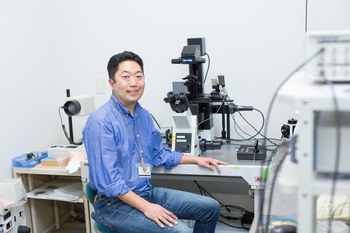Brain Pathology
- Brain Pathology (Laboratory of Neuronal Regeneration)
- Brain Pathology (Laboratory of Ion Channel Pathophysiology)
Laboratory of Ion Channel Pathophysiology

Hiroaki Misono, Ph.D.
Our research focuses on the Neurobiology of protein regulation, particularly ion channels and Alzheimer’s tau protein. Ion channels are the engine that generates electrical signals for neurons to transmit signals and to compute. We aim to understand how hundreds of different ion channels work in individual neurons, in neural network, and in animals. At the moment, we particularly focus on studying the roles of tau protein in normal and in Alzheimer’s disease.
The functioning of the brain relies critically on the precise control of electrical excitability of billions of neurons, which are interconnected. However, in certain cases, the brain fails to effectively regulate neuronal excitability and falls into pathological conditions such as stroke and epilepsy. Controlling electrical excitability is a major role of voltage-gated potassium (Kv) channels by counteracting membrane depolarization. Neurons express wide varieties of Kv channels, either on the somata, dendrites, or axons. These potassium channels act to achieve rapid and precise control of the local and global membrane excitability. In doing so, they effectively regulate the overall input-output relationship between synaptic stimuli to dendrites and neurotransmitter release from axon terminals. Therefore, altering the surface density, location, or functional characteristics of Kv channels profoundly affects neuronal signaling. The goal of my research is to understand the molecular basis of the constitutive and regulated mechanisms that dynamically change the localization and function of Kv channels, and how these impact the regulation of membrane excitability in brain neurons and thereby determine animal behaviors in health and disease.
Microtubule-associated protein tau accumulates in the cell bodies and dendrites of affected neurons in Alzheimer's disease. A lot of work has been done on whether and how accumulated (and aggregated) tau would exert toxicity and may propagate to other neurons. However, it is not clear how tau, which is localized to the axon in normal conditions, accumulates in the cell body and dendrites. We aim to understand how tau localizes to the neuronal axon and how this mechanism fails in Alzheimer's disease, and hope to provide new therapeutic approaches for the disorder through our basic research.
Current Projects
1. Molecular mechanisms of vesicular trafficking of ion channels in neurons (live-cell imaging of protein trafficking).
2. Kv channels in the regulation of sleep (EEG recording in gene knockout mice).
3. Homeostatic regulation of neuronal excitability by Kv channel conductances in health and disease (patch-clamp recording and slice electrophysiology).
4. Cellular and molecular understanding of the pathological accumulation of tau protein in Alzheimer's disease.
Selected publications
- Iwata M., Watanabe S., Yamane A., Miyasaka T., and Misonou H. * (2019) Regulatory mechanisms for the axonal localization of tau protein in neurons. Molecular Biology of the Cell, in press.
- Kubo A., Ueda S., Yamane A., Wada-Kakuda S., Narita M., Matsuyama M., Nomori A., Takashima A., Kato T., Onodera O., Goto M., M., Tomiyama T., Mori H., Murayama S., Ihara Y., Misonou H. , and Miyasaka T.* (2019) Ectopic expression induces abnormal somatodendritic distribution of tau in the mouse brain. Journal of Neuroscience, in press.
- Hirono, M.*, Watanabe, S., Karube, F., Fujiyama, F., Kawahara, S., Nagao, S., Yanagawa, Y., and Misonou, H. (2018) Perineuronal nets in the deep cerebellar nuclei regulate GABAergic transmission and delay eyeblink conditioning. Journal of Neuroscience, in press.
- Jensen, C.S., Watanabe, S., Stas, J.I., Klaphaak, J., Yamane, A., Schmitt, N., Olesen, S.P.O., Trimmer, J.S., Rasmussen, H.B., and Misonou, H. * (2017) Trafficking of Kv2.1 Channels to the Axon Initial Segment by a Novel Non-Conventional Secretory Pathway. Journal of Neuroscience 37, 11523-11536.
- Hirono M., Ogawa Y., Misono K., Zollinger D.R., Trimmer J.S., Rasband M.N., and Misonou H. * (2015) BK channels localize to the paranodal junction and regulate action potentials in myelinated axons of cerebellar Purkinje cells. Journal of Neuroscience 35, 7082-7094.
Members
Hiroaki Misono, Ph.D. (Principal investigator, Professor)
Links
Contact
| Contact |
1-3 Tatara Miyakodani, Kyotanabe-shi, Kyoto 610-0394 Japan |
|---|
|
Faculty Molecular and Cellular Neurosciences Systems Neuroscience Brain Pathology |